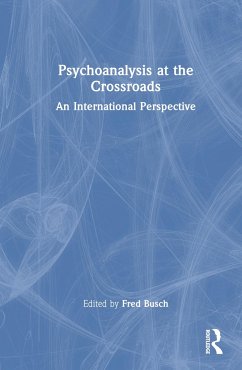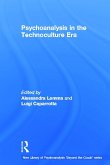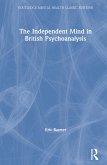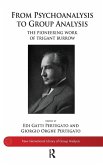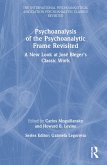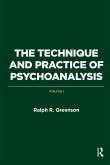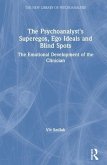Psychoanalysis at the Crossroads
An International Perspective
Herausgeber: Busch, Fred
Psychoanalysis at the Crossroads
An International Perspective
Herausgeber: Busch, Fred
- Gebundenes Buch
- Merkliste
- Auf die Merkliste
- Bewerten Bewerten
- Teilen
- Produkt teilen
- Produkterinnerung
- Produkterinnerung
In this clear and thoughtful book, an international group of distinguished authors explore the central issues and future directions facing psychoanalytic theory and practice.
Andere Kunden interessierten sich auch für
![Psychoanalysis in the Technoculture Era Psychoanalysis in the Technoculture Era]() Psychoanalysis in the Technoculture Era188,99 €
Psychoanalysis in the Technoculture Era188,99 €![The Marks of a Psychoanalysis The Marks of a Psychoanalysis]() Luis IzcovichThe Marks of a Psychoanalysis174,99 €
Luis IzcovichThe Marks of a Psychoanalysis174,99 €![The Independent Mind in British Psychoanalysis The Independent Mind in British Psychoanalysis]() Eric RaynerThe Independent Mind in British Psychoanalysis186,99 €
Eric RaynerThe Independent Mind in British Psychoanalysis186,99 €![From Psychoanalysis to Group Analysis From Psychoanalysis to Group Analysis]() From Psychoanalysis to Group Analysis187,99 €
From Psychoanalysis to Group Analysis187,99 €![Psychoanalysis of the Psychoanalytic Frame Revisited Psychoanalysis of the Psychoanalytic Frame Revisited]() Psychoanalysis of the Psychoanalytic Frame Revisited186,99 €
Psychoanalysis of the Psychoanalytic Frame Revisited186,99 €![The Technique and Practice of Psychoanalysis The Technique and Practice of Psychoanalysis]() Ralph R GreensonThe Technique and Practice of Psychoanalysis176,99 €
Ralph R GreensonThe Technique and Practice of Psychoanalysis176,99 €![The Psychoanalyst's Superegos, Ego Ideals and Blind Spots The Psychoanalyst's Superegos, Ego Ideals and Blind Spots]() Vic SedlakThe Psychoanalyst's Superegos, Ego Ideals and Blind Spots165,99 €
Vic SedlakThe Psychoanalyst's Superegos, Ego Ideals and Blind Spots165,99 €-
-
-
In this clear and thoughtful book, an international group of distinguished authors explore the central issues and future directions facing psychoanalytic theory and practice.
Hinweis: Dieser Artikel kann nur an eine deutsche Lieferadresse ausgeliefert werden.
Hinweis: Dieser Artikel kann nur an eine deutsche Lieferadresse ausgeliefert werden.
Produktdetails
- Produktdetails
- Verlag: Taylor & Francis
- Seitenzahl: 326
- Erscheinungstermin: 15. März 2023
- Englisch
- Abmessung: 234mm x 156mm x 21mm
- Gewicht: 658g
- ISBN-13: 9781032375496
- ISBN-10: 1032375493
- Artikelnr.: 66736477
- Herstellerkennzeichnung
- Libri GmbH
- Europaallee 1
- 36244 Bad Hersfeld
- gpsr@libri.de
- Verlag: Taylor & Francis
- Seitenzahl: 326
- Erscheinungstermin: 15. März 2023
- Englisch
- Abmessung: 234mm x 156mm x 21mm
- Gewicht: 658g
- ISBN-13: 9781032375496
- ISBN-10: 1032375493
- Artikelnr.: 66736477
- Herstellerkennzeichnung
- Libri GmbH
- Europaallee 1
- 36244 Bad Hersfeld
- gpsr@libri.de
Fred Busch has published numerous articles on psychoanalytic technique, and he has been invited to present papers and clinical workshops nationally and internationally. His last four books: Creating a Psychoanalytic Mind (2014); The Analyst's Reveries: Explorations in Bion's Enigmatic Concept (2019); Dear Candidate (2020); A Fresh Look at Psychoanalytic Technique (2021).
Introduction Part One: What is Basic in Psychoanalytic Technique and
Theory? 1. Waking a Sleeping Beauty 2. New Forms of Psychopathology in a
Changing World: a Challenge for Psychoanalysis in the Twenty-First Century
3. A Turn Towards or a Turn Away? Why and How Resistance to Unbearable
Ideas Evoked in the Analyst's Presence Must be the Cornerstone of
Psychoanalytic Work 4. The Relational Unconscious: A Core Element of
Intersubjectivity, Thirdness, and Clinical Process 5. How to Grow a
Psychoanalytic Forest: A Challenge Going Forward 6. Affirming: "That's Not
Psychoanalysis!": On the Value of the Politically Incorrect Act of
Attempting to Define the Limits of our Field 7. Psychoanalysis and its
Future: Destiny at the Crossroads 8. Technique at the Crossroads 9. Those
Who Listen 10. Crossroads, Cloverleaf Overpass, or Skein: The Relationship
Between Some Neurocognitive Research and the Development of the Unconscious
Mind Part Two: Psychoanalysis and Social Issues 11. Difference: Our Legacy
and Our Future 12. Conviction, Lies and Denialism: Psychoanalytic
Reflections 13. First Do No Harm 14. On Whiteness, Racial Rhetoric,
Identity Politics, and Critical Race Theory: A Critical Moment in American
Psychoanalysis Part Three: The Role of Psychoanalytic Institutes 15. The
Training and Supervising Analyst System in the United States, Current
Issues 16. Why Does Psychoanalytic Education Cause Such Dissension? 17.
Psychoanalytic Institutes and their Discontents 18. A Perspective from
Buenos Aires Part Four: New Directions 19. The Self as Mental Agent:
Explorations of a Long-Neglected Concept 20. Another Perspective on Dreams:
The Dream as an Experience 21. Intersections Between the Feminine and the
Infantile
Theory? 1. Waking a Sleeping Beauty 2. New Forms of Psychopathology in a
Changing World: a Challenge for Psychoanalysis in the Twenty-First Century
3. A Turn Towards or a Turn Away? Why and How Resistance to Unbearable
Ideas Evoked in the Analyst's Presence Must be the Cornerstone of
Psychoanalytic Work 4. The Relational Unconscious: A Core Element of
Intersubjectivity, Thirdness, and Clinical Process 5. How to Grow a
Psychoanalytic Forest: A Challenge Going Forward 6. Affirming: "That's Not
Psychoanalysis!": On the Value of the Politically Incorrect Act of
Attempting to Define the Limits of our Field 7. Psychoanalysis and its
Future: Destiny at the Crossroads 8. Technique at the Crossroads 9. Those
Who Listen 10. Crossroads, Cloverleaf Overpass, or Skein: The Relationship
Between Some Neurocognitive Research and the Development of the Unconscious
Mind Part Two: Psychoanalysis and Social Issues 11. Difference: Our Legacy
and Our Future 12. Conviction, Lies and Denialism: Psychoanalytic
Reflections 13. First Do No Harm 14. On Whiteness, Racial Rhetoric,
Identity Politics, and Critical Race Theory: A Critical Moment in American
Psychoanalysis Part Three: The Role of Psychoanalytic Institutes 15. The
Training and Supervising Analyst System in the United States, Current
Issues 16. Why Does Psychoanalytic Education Cause Such Dissension? 17.
Psychoanalytic Institutes and their Discontents 18. A Perspective from
Buenos Aires Part Four: New Directions 19. The Self as Mental Agent:
Explorations of a Long-Neglected Concept 20. Another Perspective on Dreams:
The Dream as an Experience 21. Intersections Between the Feminine and the
Infantile
Introduction Part One: What is Basic in Psychoanalytic Technique and
Theory? 1. Waking a Sleeping Beauty 2. New Forms of Psychopathology in a
Changing World: a Challenge for Psychoanalysis in the Twenty-First Century
3. A Turn Towards or a Turn Away? Why and How Resistance to Unbearable
Ideas Evoked in the Analyst's Presence Must be the Cornerstone of
Psychoanalytic Work 4. The Relational Unconscious: A Core Element of
Intersubjectivity, Thirdness, and Clinical Process 5. How to Grow a
Psychoanalytic Forest: A Challenge Going Forward 6. Affirming: "That's Not
Psychoanalysis!": On the Value of the Politically Incorrect Act of
Attempting to Define the Limits of our Field 7. Psychoanalysis and its
Future: Destiny at the Crossroads 8. Technique at the Crossroads 9. Those
Who Listen 10. Crossroads, Cloverleaf Overpass, or Skein: The Relationship
Between Some Neurocognitive Research and the Development of the Unconscious
Mind Part Two: Psychoanalysis and Social Issues 11. Difference: Our Legacy
and Our Future 12. Conviction, Lies and Denialism: Psychoanalytic
Reflections 13. First Do No Harm 14. On Whiteness, Racial Rhetoric,
Identity Politics, and Critical Race Theory: A Critical Moment in American
Psychoanalysis Part Three: The Role of Psychoanalytic Institutes 15. The
Training and Supervising Analyst System in the United States, Current
Issues 16. Why Does Psychoanalytic Education Cause Such Dissension? 17.
Psychoanalytic Institutes and their Discontents 18. A Perspective from
Buenos Aires Part Four: New Directions 19. The Self as Mental Agent:
Explorations of a Long-Neglected Concept 20. Another Perspective on Dreams:
The Dream as an Experience 21. Intersections Between the Feminine and the
Infantile
Theory? 1. Waking a Sleeping Beauty 2. New Forms of Psychopathology in a
Changing World: a Challenge for Psychoanalysis in the Twenty-First Century
3. A Turn Towards or a Turn Away? Why and How Resistance to Unbearable
Ideas Evoked in the Analyst's Presence Must be the Cornerstone of
Psychoanalytic Work 4. The Relational Unconscious: A Core Element of
Intersubjectivity, Thirdness, and Clinical Process 5. How to Grow a
Psychoanalytic Forest: A Challenge Going Forward 6. Affirming: "That's Not
Psychoanalysis!": On the Value of the Politically Incorrect Act of
Attempting to Define the Limits of our Field 7. Psychoanalysis and its
Future: Destiny at the Crossroads 8. Technique at the Crossroads 9. Those
Who Listen 10. Crossroads, Cloverleaf Overpass, or Skein: The Relationship
Between Some Neurocognitive Research and the Development of the Unconscious
Mind Part Two: Psychoanalysis and Social Issues 11. Difference: Our Legacy
and Our Future 12. Conviction, Lies and Denialism: Psychoanalytic
Reflections 13. First Do No Harm 14. On Whiteness, Racial Rhetoric,
Identity Politics, and Critical Race Theory: A Critical Moment in American
Psychoanalysis Part Three: The Role of Psychoanalytic Institutes 15. The
Training and Supervising Analyst System in the United States, Current
Issues 16. Why Does Psychoanalytic Education Cause Such Dissension? 17.
Psychoanalytic Institutes and their Discontents 18. A Perspective from
Buenos Aires Part Four: New Directions 19. The Self as Mental Agent:
Explorations of a Long-Neglected Concept 20. Another Perspective on Dreams:
The Dream as an Experience 21. Intersections Between the Feminine and the
Infantile

